Wildlife Response, Inc. is a distinctive 501c3 volunteer organization devoted solely to the care of orphaned, injured, and displaced native wildlife. We are dedicated to increasing awareness of wildlife rehabilitation to the public. Our organization depends primarily upon the private donations for its programs and services.
The Wildlife Response and Rehabilitation Center will be a centrally located facility where citizens, animal control officers and other agencies can drop off wildlife. In addition, the Center will provide a redistribution center for animals to be triaged, and then sent to permitted-based wildlife rehabilitators for care. The Center is expected to open in 2025.
Education
Mink and Weasel Family
|
Mink are born both curious and secretive. They are usually shy but can be very bold when their curiosity has been aroused. They are solitary with the exception of mating season. The American mink shares the common characteristic of all mustelids: anal musk glands that are used for territory marking and defense. As members of the weasel family, their bodies are long and slender with long necks and short legs. Mink range in size from 12 to 17 inches in length. Males are larger than females. Females range in weight from 1 ¼ to 2 pounds. Males range in weight from 1 ½ to 3 pounds. The fur is a rich dark brown to almost black with a white chin patch and throat. Sometimes they have small white spots on their belly. The fur is soft and thick with oily guard hairs that waterproof the coat. A mink’s pelt has a thick under-fur for insulation and buoyancy. The tail is fully furred and slightly bushy. The eyes appear black and are beady in appearance. They have fair eyesight and must rely on their sense of smell to locate prey. A mink’s ears are short, barely extending above its fur. The feet have five toes which are slightly webbed, making mink excellent swimmers. They use all four feet when swimming and are able to dive as deep as 16 feet. They are capable of swimming underwater distances of 50 feet. Mink can reach a top surface swimming speed of 1 to 1 ½ miles per hour. On land, they usually walk or take low bounds covering a distance of between 10-24 inches with each bound. They are capable of running 7-8 miles per hour. They will often rear up on their hind legs to get a better view of their surroundings, and will sometimes climb trees to avoid predators. They will spray a foul smelling liquid when frightened and may squeal, snarl, or hiss. They can make a purring sound when happy and will greet with a bark. Mating takes place between January and March. Females may breed their first year. The average life span is one year but they may live as long as 4 years. Litters of 2-6 are born blind, naked and helpless. Eyes open around 212-25 days. Abandoned burrows dug by muskrat are a favorite place to rest and raise their young. They will also use cavities in brush and rock piles, logjams, and the exposed roots of trees. A den can have several entrances, and includes a nest chamber about 1 foot in diameter. The female usually lines this chamber with grass, leaves, fur or feathers. Mother begins to wean at 5 weeks by bringing home food. Young mink have a surplus of skin at the back of the neck, which protects them from mother’s sharp teeth when she picks them up. By 8 weeks, the weaning process is over and the young mink begin traveling with their mother on hunting trips. Young mink are playful and begin to play fight. They will travel in single file and will mimic mother’s behaviors. They remain with their mother until the end of summer. As fall approaches, the young mink will leave to establish their own territory. The larger males disperse first and the females may not disperse until the following spring. The young mink may establish territory as far away as ten miles. By the age of ten months they are able to mate. Females reach their full growth by the following fall but males continue to grow into their second year. Mink prefer a habitat beside streams and lakes. They are chiefly nocturnal and very secretive. They are rarely seen by humans and are solitary except for family groups of mothers and young. Mink are almost as dependent on access to water as the river otter. The mink will have a narrow territory not more than 150-300 feet from a lake , stream, marsh or river bank. A permanent water source, reliable amount of prey and adequate shoreline vegetation , such as cattails, are important to a mink’s choice of habitat. A male mink travels widely and may occupy as much as 2.5 miles of stream habitat or 2500 acres in wetland habitat. An adult female does not travel as far as the male. Her territory covers about 1 mile of stream habitat and 40 acres of wetland habitat. Males defend their territory against other males. A male may use several different dens within its range. The female usually only has one or two dens and is the only one to use them. Juveniles that have recently left the family group often use several dens until they establish their own territory. There is usually 1 mink for each 50 acres of wetlands and 3-4 mink for each mile of stream habitat, when food is ample. Wild mink are less common than 50 years ago due to habitat loss caused by development, stream channelization and drainage of wetlands. Mink mark their territory and advertise their presence by depositing their droppings and leaving its scent in prominent spots, such as rocks or logs. Mink are active year round, remaining in the den only during severe winter weather. Despite their size, mink are vicious predators. The mink is extremely aggressive and capable of attacking and killing animals much larger than itself. They are seldom if ever interested in plant food. They feed primarily on birds, eggs, frogs, crayfish, and fish. They seldom eat insects or carrion. The males, being larger in size, will also prey on rabbits, large birds, and muskrat. Prey are usually killed and taken to the den to eat. Mink perform a valuable service to man by controlling the small rodent population. It will cache food for later if the prey is larger than it can eat at one time. Mink are preyed on by owls, fox, coyotes, bob cats and domestic dogs and cats. Other reasons for mortality include fighting with other mink, starvation of dispersing juveniles and trapping.
Unlike most other predatory animals, weasels are active both day and night. Evidence suggests that they are better suited to hunting during the day, especially twilight. They are efficient predators and active year round. A weasel’s eyes have a reflective layer of tissue called the tapetum lucidum behind the retina to improve night vision. In the tracks of a weasel, the hind feet and front feet are superimposed . As a result, the tracks look like they were made by two feet instead of four. They have furred foot pads which allow for quickly running over snow. Weasels, like all mustelids, produce a pungent odor called “musk”. When irritated they will discharge their musk as a defense strategy. The long tail weasel has a long, slender body and neck, short legs and a tail, that measures 40-70% of its body length. The upper body fur is brown and the under parts are yellowish white. The long tail weasel has brown feet in summer, where the other members of the weasel family have white feet. The mature long tail weasel has a black tip at the end of the tail. A study was done by a researcher named Roger Powell on the purpose of the black tip. In this study, he trained captive hawks to capture fake weasels. The hawks repeated focused on trying to capture the black tip, with little success. When the fake weasels were replaced with like weasels without the black tip, the hawks were more successful by attacking the body. Powell, concluded that the black tip is a natural diversion to elude predators. Adult males weigh 7 ½ to 12 ounces and females usually weigh 3 ¼ to 7 ½ ounces. Adult males are 12 ½ to 20 inches in length, with a tail length possible of 6 inches. Females are by contrast only 10-16 1/8 inches in length and maximum tail lengths of 5 ½ inches.
The long tail weasel has a home range of 30 to 40 acres. Males have larger ranges than females and do not overlap with other males. Males tend to circulate through their territory, visiting one hunting spot after another. One study found that the male long tail weasels traveled about 230 yards per night in comparison to the female’s 115 yards per night. Dens are usually in a hollow tree or log or some protected place. They will line the den with grass, leaves, fur or feathers. Weasels will occupy a wide variety of habitats including woodlands, brushy areas and borders between woodlands and fields. The density of a population will depend on the season and food availability. Long tail weasels mate in late summer mostly from July through August. They do not give birth until the next April or May. Average litters consist of 6 young, but 9 are possible. The young are born blind and are covered with a fine whitish fur. Their eyes open at 5 weeks. The mother feeds only milk at first but will introduce prey before the eyes open. They mature rapidly and at 3 months of age the females are fully grown. They are mature at the age of one. Due to their secretive nature, very little is known about their social and family life. They are believed to have a wild lifespan of 3 to 5 years. Weasels are preyed upon by snakes, owls, hawks, foxes and occasionally domestic cats.(reprinted with permission from Wild at Heart)
|
Great Horned Owl
The Great Horned Owl mates in Late January or early February laying 2-3 eggs once a year. The eggs are incubated by both parents and hatch in about four weeks. The owls mature quickly. This owl is found across North America in valleys, grasslands, woodlands, forests and city parks. Here in the Hampton Roads area it is found everywhere. They eat mainly squirrels, rabbits, small mammals and other birds but are not limited to that diet. They swallow their food whole and later regurgitate what their body cannot process in owl pellets. They have excellent hearing and fly silently through the air that aids in hunting nocturnally. They will swoop down to catch their prey with powerful feet and talons. Territories. The territory for a mated pairs may range 1/3 of a mile to 2-5 square miles. Some ornithologists (scientists who study birds) believe that owls form permanent pair-bonds. If one; after the courtship displays end, the male continues to hoot to maintain territory and the female remains near the selected nest until time to lay the eggs. She lays them in the debris (wood chips or other plant matter) in the bottom of the nest. The number of eggs laid seems to be linked to available food supplies. Normally the female lays 2-3 dull white, thick-shelled, oval-shaped eggs. Owls lay only one clutch of eggs per season. Some females nest only every other year. Females in prime habitat may nest every year.
|
Foxes of North America
The Red Fox (vulpes fulva)
The Gray Fox (urocuon ceneroargenteus)
The Arctic Fox (alopex lagopus)
The Kit Fox (vulpes velox)
There are four types of foxes in North America- the red, the gray, the arctic and the kit. Many of their characteristics are the same, but each has its own interesting differences. The fox is the smallest of the wild dogs of North America. It is one of the most intelligent of the wild animals and is very adaptable.
The most significant feature of a fox is its “brush” or tail, which is extremely important in cold weather. The fox will curl up tightly and cover the nose, paws and legs with the tail. The tail also plays a significant role in fox language to convey messages of dominance, submissiveness, aggression and playfulness. The tail is a third of the fox’s body length. Only the red fox has the white tip.
All foxes have oval- shaped eyes, which differs from the other members of the dog family, which have round eyes. The red fox has vertical pupils that can narrow to a slit, thus reducing the amount of bright sunlight. They also have a reflective membrane which causes the light to pass over the retina twice, greatly improving night vision.
The fox’s vibrissae (whiskers) are cat-like. They are longer than their wild dog cousins. A fox has a well developed sense of hearing. It can easily hear a mouse rustling under 2 feet of snow or grassy area.
Foxes are capable of leaping 15 feet or more.
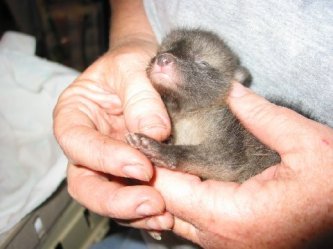 Foxes are quick learners and have been known to follow farmers mowers at haying time. They will snap up mice and voles injured or exposed by the haying process. Foxes are preeminent mousers without the aid of the farmer. They will also consume moles and voles. A fox’s wild diet includes grasshoppers, crickets, small birds, squirrels, rabbits, young woodchucks, snakes and lizards. They will occasionally take larger birds, such as pheasants and ducks. They also eat berries and fruit, such as grapes, apples and raspberries. They will eat about 1 pound of meat at a time. Red fox will bury or cache abundant prey in the summer and dig it up when food is scarce.
Foxes are quick learners and have been known to follow farmers mowers at haying time. They will snap up mice and voles injured or exposed by the haying process. Foxes are preeminent mousers without the aid of the farmer. They will also consume moles and voles. A fox’s wild diet includes grasshoppers, crickets, small birds, squirrels, rabbits, young woodchucks, snakes and lizards. They will occasionally take larger birds, such as pheasants and ducks. They also eat berries and fruit, such as grapes, apples and raspberries. They will eat about 1 pound of meat at a time. Red fox will bury or cache abundant prey in the summer and dig it up when food is scarce.
Foxes have numerous cries, calls and sounds. They do not howl like their wolf cousins. They do have a shrill alarm bark used to warn kits of danger when they are old enough to leave the den.
Foxes are sexually mature by the age of one. Late January is the typical mating season. The gray fox mating ritual is more aggressive than that of the red. Fox mating rituals involve an extended period of chasing that may last up to two weeks. During this time the fox will urinate a strong skunk-like odor. The male and female will separate for a time after mating. The vixen( female) will seek a den just before time for birthing.
A den site can often be detected by worn trails leading to it or by left over bones, feathers, etc. may be spotted. Red foxes prefer making their dens in an environment that allows easy digging. They will also enlarge an existing den of a woodchuck, skunk or another fox. Gray fox will use a ground den but prefer a hollow log or a hollow tree. The gray fox is not tidy about its den area, so you will more likely find bones from fish, birds or rabbits near the den site of the gray fox.
The dog fox ( male) will join the vixen to raise the kits. Kits are usually born in March or April. The typical litter size for all fox species will be 4 kits.
After the vixen gives birth, she will remain in the den for several days. The male will bring food to her during this time. The kit’s eyes do not open for ten days. At the age of 3 to 4 weeks, kits remain near the den opening. At 4 weeks, the kits will begin to fight each other. This is a means of establishing a dominance hierarchy, which determines which kit is fed first by the parents. If food becomes scarce, the dominant kits may be the only ones to survive. Fox kits are vulnerable to a number of predators including eagles, hawks, owls, coyotes and man. At approximately 8 weeks of age, the vixen will force the kits to stop nursing. Around the age of nine weeks,in early fall, young fox are able to feed themselves. They will begin to disperse in the fall after 10 weeks of age.
Foxes are highly territorial. The resident dog fox or vixen will savagely attack an intruder.
The average life span of a wild fox is 5 years. An adult fox’s small size makes it prey for wild cats, coyotes and wolves. Foxes are also affected by rabies, distemper and mange.
The Red Fox is found in every state with the exception of Florida. It is found across Canada to the arctic tundra. It can be found in mountains, forests and farmlands.
Legends about the red fox are many. Some American Indians considered the clever red fox the devil on earth.
The red fox is one of nature’s loveliest and most elegant creatures. The scientific name “vulpes” is the Latin word for fox. The classification “fulva” is from the Latin meaning of reddish- yellowish. It is sometimes called the cat-like fox.
Red fox fossils in North America have been dated back to sometime before the arrival of Columbus.
The red fox stands about 15 inches at the shoulder and weighs between 8 and 14 pounds. Red foxes are not always red. The “silver fox” is the black phase of the red and the “cross fox” is a red fox with dark fur in the shape of a cross down the back and across the shoulders.
Red foxes are stealth hunters. Both the red and gray fox will hunt during the day if they feel secure and have ample hiding places. Reds hunt in the same manner as a small cat. When possible, they will stalk their prey and either pounce on it or run it down with a quick burst of speed. Red foxes are solitary hunters. The red can partially retract its claws, which permits it to stalk quietly, helps the claws stay sharper ,which aids in pinning the prey. Red foxes will prey on anything they can catch and kill.
If chased, a red fox will leap a distance or travel down a stream to put distance between its foot track. They are capable of running 30 miles per hour for several miles, leap obstacles up to six feet in height and easily swim across rivers and streams.
The Gray Fox has a similar range to the red. Its genus name is”urocyon cineroargenteus”. The gray fox tends to avoid areas that have very cold weather. It will inhabit areas of habitat that the red fox avoids. It prefers wooded areas and is not found in the plains states or the western mountain states of the U.S. Sometimes called the “tree fox”, the gray fox will climb up a leaning tree to take a nap in the lower branches. Grays have been seen eating eggs or young nestlings out of their nests. Gray foxes will also climb a tree to escape predators. They will climb on to a leafy branch and flatten themselves to avoid detection. The gray fox is less likely to live near humans. It is also less likely to be seen, as it prefers to move about at night.
The fur of a gray fox is usually a silvery gray but may have also have markings of black, orange and white. The underside will usually be white or light gray. The gray’s tail will be tipped in gray or black. The gray fox weighs less than the red but its body is longer. They typically stand 15 inches at the shoulder and will weigh between 7 and 11 pounds.
The gray fox is the best fighter in the fox clan. A gray fox will stand up to a single dog and easily drive it away.
The Kit Fox (vulpes velox) is the smallest of the North American foxes. It is found in the desert and plains areas of the United States. Its range in the U.S. is limited. It prefers dry, brushy areas. It is sometimes called the “swift fox” due to its habit of darting after things and the speed at which it does this.
The kit fox’s fur is yellowish gray with light colored underbelly. The tail is tipped in black. The adult weight ranges between 4 and 6 pounds and it stands 12 inches at the shoulder. The kit fox family life differs from his cousins as the off-spring remain with the parents for one year before dispersing on their own.
The kit fox prefers a nocturnal life. It spends the day in a burrow and always digs a second entrance for escape. Most foxes will run if surprised, but the kit fox will freeze and lay close to the ground.
A kit fox’s diet will include ground squirrels, prairie dogs, rabbits, snakes, lizards, small birds and insects. It will eat grass and berries if meat is not available.
The kit fox has the longest ears of the foxes and its vocalizations are more like the “chatter” of squirrels than the yelping and yapping of the other fox clan members. The kit fox does not tolerate human presence and requires a desert habitat to survive.
The Arctic Fox (alopex lagopus) looks least like its cousins. It has a shorter nose, short rounded ears, stands less than 12 inches at the shoulder and is the heaviest of the foxes, weighing in at 15 pounds.
Another unusual trait is that it changes its fur color with the seasons. Summer will find it in the brown phase and white during the winter.
It tolerates people more than the other species and will follow hunters and trappers in hopes of an easy meal. Winter feeding for the arctic fox is usually leftovers from a larger animal’s kill or a whale that has beached itself. In summer, its diet includes lemmings and other rodents, ptarmigan, as well as other bird’s eggs.
Their fur is the softest in the fox family. Young are raised in hillside dens in spring in a similar fashion to its fox cousins. By fall, as with other foxes, the young are able to care for themselves.(reprinted with permission from Wild at Heart)
Gray Squirrel
Almost every activity of the modern gray squirrel involves food. Adult gray squirrels consume roughly one and a half pounds of nuts and seeds a week. Natural foods include a variety of seeds, nuts, fruit, buds, leaves, bark, and fungi. Favorite nuts include hickory, pecan, black walnut and acorns. Favorite seeds include pine, corn, black gum fruits, sugar maple, dogwood fruits, wild cherry and beechnut. Gray squirrels will eat between 30 and 60 different plants. They are omnivores. They will occasionally eat bird eggs, earthworms and beetles. They will also eat soil to obtain minerals. They will strip bark on a tree to sharpen their teeth and obtain nutrients from the sappy tissue beneath the bark. Their diet may also include mushrooms , the bones of dead animals and deer antlers. They require water at least twice a day. In winter, they will eat the snow to obtain water. Gray squirrels are scatter hoarders. They bury small amounts of food in different locations. They are capable of burying 25 nuts per hour. Experiments have shown that they use their highly developed sense of smell to locate their buried treasures. In spring, swelling buds and the flowers of the red and sugar maple are eaten. Summer food will include berries, apples, corn and other grains. Squirrels are most active at dawn and in the late afternoon. Wind discourages movement. Squirrels are somewhat gregarious, tolerating each other in small groups when food is plentiful. Squirrels are active year round. They may stay in their den for several days during storms or severe winter weather. In winter, several immature squirrels may share the same nest. Squirrels use two kinds of nests: tree dens and leaf nests called dreys. Leaf nests are usually summer nests. They will be built in the top fork of a tree or in the crotch of a limb neat the trunk. A single entrance usually faces the main trunk or a nearby limb. The number of active nests per squirrel is thought to be about three, depending on the density of squirrels in the area. Nest sites are periodically changed to keep parasites under control. Most squirrels are capable of constructing a nest in one day. Additional material is added from time to time. The diameter of the interior nest is usually 6 to 8 inches.
The life expectancy of a gray squirrel is 10 years but the average life span is 18 months. An old squirrel would be 4 years old. An estimated 15 to 25 percent of young squirrels survive their first year. After the first year there is a 50 to 70 percent survival rate. About 1 percent of squirrels in a given year will survive longer than 5 years. Natural predators include man, hawks, owls, fox, bobcats and raccoons. The greatest cause of death for squirrels is due to a combination of lack of food, secondary infection from parasites and effects of cold weather. Squirrel language includes a vocabulary of slow warning barks, scolding, teasing and playful “clucks”. When alarmed, jerky tail movements will accompany its call. Squirrels use their calls and tail movements to warn other squirrels of danger, as well as, to intimidate their adversaries. The tail is also used for shade in the summer and a blanket in winter. The tail is used for balance when climbing and jumping. A gray squirrel’s teeth are its most important tool. Their sharp incisors enable them to gnaw through the outside of nuts, as well as wood and plastic. The incisors will grow about 6 inches in a year and must be constantly worn down by eating or chewing.
The squirrel’s fur is its first defense against the cold. It is a mixture of brown, grey and yellow on top with gray and white underneath. The range of fur color may run from gray to silver-gray to black. Extra sensitive hairs called “vibrissae” form the whiskers. The whiskers give them accurate information on the size of an opening they wish to enter. Baby squirrels are born with these facial hairs, which help them find their mother in the nest. The underneath coloring pattern of the tail can provide information on the age of a squirrel. In gray squirrels, juvenile tails have a stripe pattern to the fur. Squirrels that are 16 months and older do not have the striped variation in their tail fur.(reprinted with permission from Wild at Heart)
|
Eastern Snapping Turtle
They prefer dead but not rotting fish but they will also eat, crayfish, toads, frogs, terrestrial insects, muskrats, aquatic plants and algae. The adult snappers have one primary predator; MAN!!! |
Subcategories
Education and Outreach Main
Education & Outreach
WRI promotes community education as well as wildlife rehabilitation education in Southeastern Virginia. We are dedicated to the preservation of wildlife through rehabilitation and education. It is essential for the public to understand the sensitive balance of human and non-human populations, the affect we have on the natural environment, and the best ways in which we can coexist.
Community Education
WRI puts the WILD in wildlife education! Our knowledgeable, professional, and passionate staff will entertain and educate through close encounters with real live animals! Nothing has a greater impact than the sight of a Great Horned owl or Red-tailed Hawk just feet away! WRI presents exciting and educational programs at nearly any venue and for any age group. Sample organizations include: school groups, community associations/civic leagues, senior facilities, etc.
Wildlife Rehabilitator Education
WRI offers a wide range of training class in-person and online. Depending upon your permit needs, we have licensed volunteers ready to help you learn more about becoming a wildlife rehabilitator or maintaining your license. Checkout our self-pace learning classes.
Community Outreach
Community outreach programs are offered by a licensed wildlife rehabilitator and are available year round. We have four education ambassador animals that we can use to educate the community about wildlife. Photos can also be taken with the animals. The Program is exciting, humorous and very educational. The program usually lasts about 1 hour.
We provide programming for all ages including community associations, schools, scouts, churches, daycares, libraries, senior groups, and more. Reservations need to be made at least 4 weeks in advance. There is no charge.
To schedule a presentation or exhibit, email This email address is being protected from spambots. You need JavaScript enabled to view it.

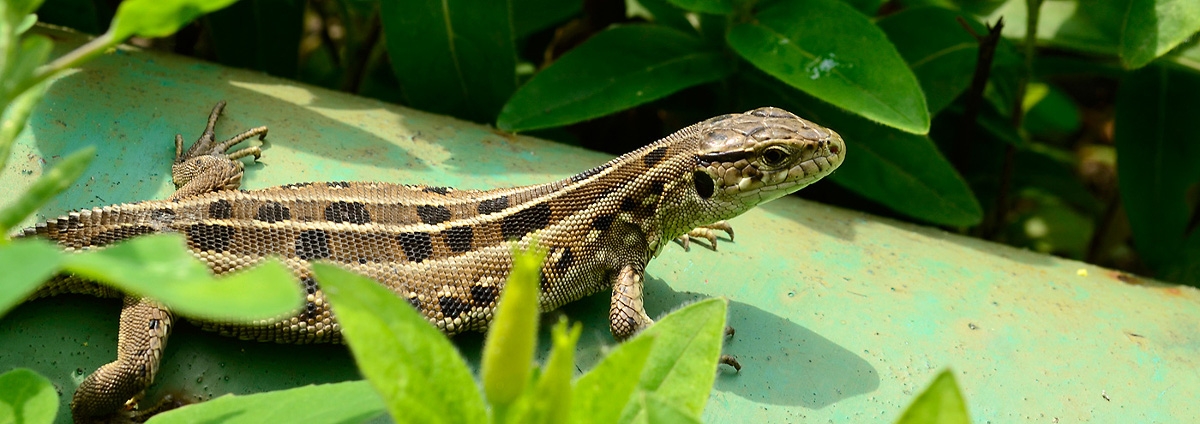

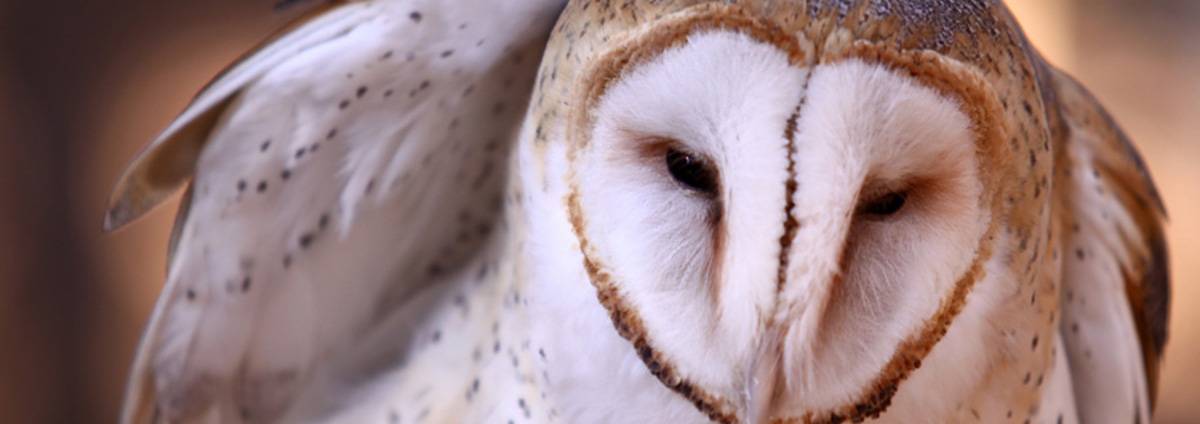
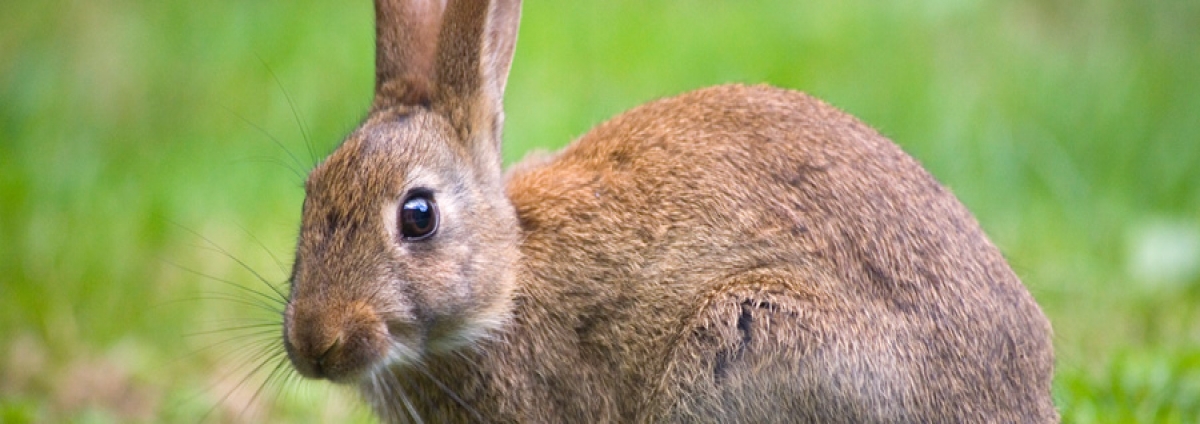
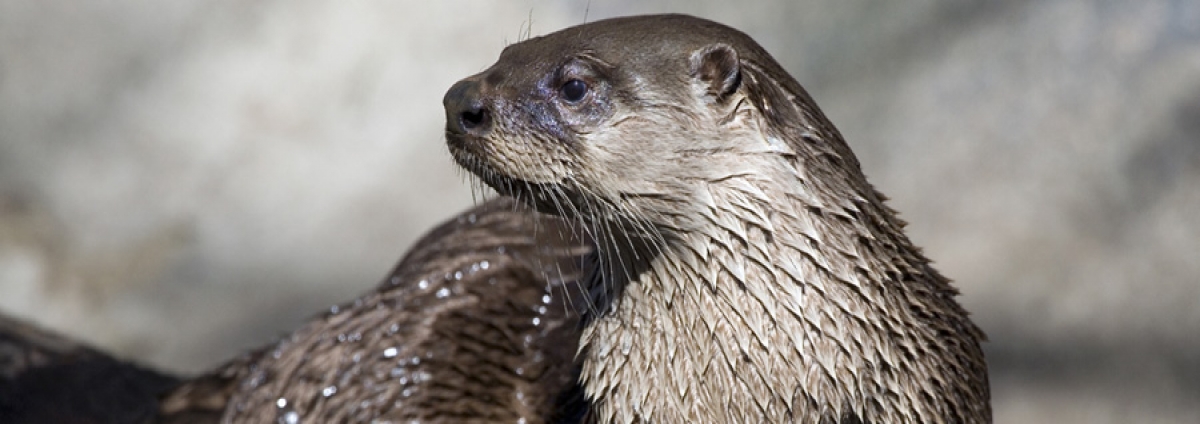
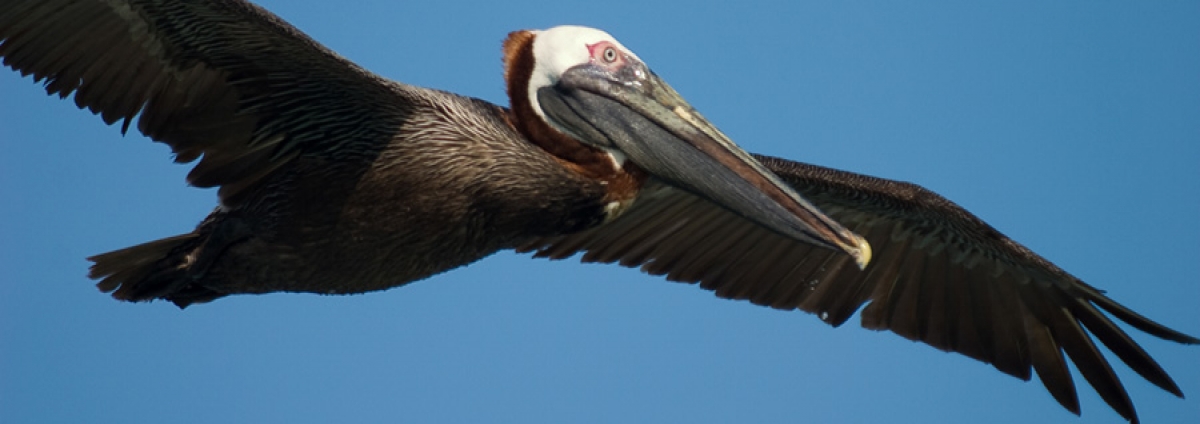
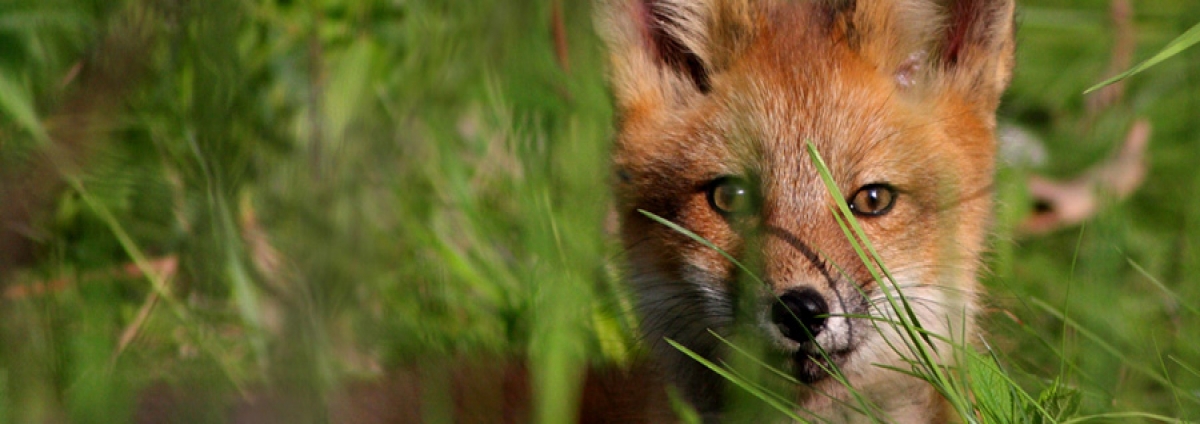
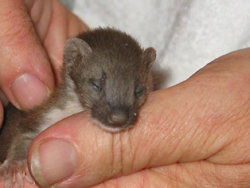 The American Mink (mustela vision) is a member of the family of animals known as mustelids. The mustelid family is known for their feistiness and are often described as fearless. The common name for mink comes from the Swedish word maenk.
The American Mink (mustela vision) is a member of the family of animals known as mustelids. The mustelid family is known for their feistiness and are often described as fearless. The common name for mink comes from the Swedish word maenk.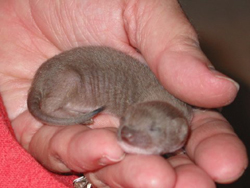 Mink are excellent environmental indicators. Wild mink are subject to a bio-accumulation of dangerous chemicals, such as mercury, because they are at the top of the aquatic food chain. The Illinois Environmental Protection Agency found that the study of mink caught by trappers, was an important addition to water quality tests. The water samples did not always provide a complete picture of how compounds accumulate through the food chain or affect wildlife when they interact with each other in an animal’s body. Through this study, people were warned not to consume fish in certain areas due to the high levels of mercury found in the mink’s system. Mink are also susceptible to Aleutian mink disease virus, a form of the parvovirus.
Mink are excellent environmental indicators. Wild mink are subject to a bio-accumulation of dangerous chemicals, such as mercury, because they are at the top of the aquatic food chain. The Illinois Environmental Protection Agency found that the study of mink caught by trappers, was an important addition to water quality tests. The water samples did not always provide a complete picture of how compounds accumulate through the food chain or affect wildlife when they interact with each other in an animal’s body. Through this study, people were warned not to consume fish in certain areas due to the high levels of mercury found in the mink’s system. Mink are also susceptible to Aleutian mink disease virus, a form of the parvovirus.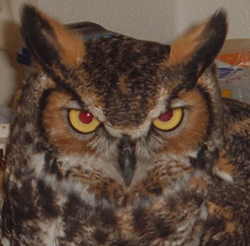 The Great Horned Owl is one of the larger owls in North America. The Great Horned Owl average size is 22 inches long with a wingspan of about 3 feet. The “horns” are only tufts of feathers. They are brown with some spotted coloration in darker shades of brown.
The Great Horned Owl is one of the larger owls in North America. The Great Horned Owl average size is 22 inches long with a wingspan of about 3 feet. The “horns” are only tufts of feathers. They are brown with some spotted coloration in darker shades of brown.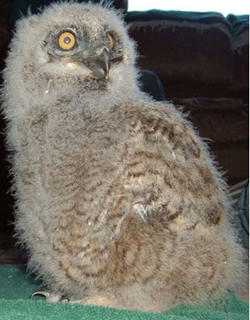 Owlets begin growing their primary feathers (main, adult feathers) at 3 weeks of age. They have light yellow eyes with blue pupils. Less brooding is necessary and they are very active about the nest. Owlets learn to eject excrement (body waste) over the side of the nest but sometimes fall due to their clumsiness. About this time the owlets begin using a defensive display when disturbed. They raise their feathers, fan their wings downward, and hiss or snap their bill.
Owlets begin growing their primary feathers (main, adult feathers) at 3 weeks of age. They have light yellow eyes with blue pupils. Less brooding is necessary and they are very active about the nest. Owlets learn to eject excrement (body waste) over the side of the nest but sometimes fall due to their clumsiness. About this time the owlets begin using a defensive display when disturbed. They raise their feathers, fan their wings downward, and hiss or snap their bill. Squirrels evolved between fifty- four and fifty- seven million years ago. The name “sciurus” is derived from a Greek word meaning “shade Tail”. They are a member of the rodent family of mammals. The word rodent is derived from the Latin word “rodere”, meaning “to gnaw”. During the micene era the ancestor of the squirrel evolved. Roughly 25 million years ago, squirrels diversified into tree and ground dwelling species. The specific origin of the gray squirrel is unknown. The fossilized predecestors of squirrels are classified as “paramyids”, the earliest form of rodent. This species varied in size from a few inches to beaver sized. Modern beavers are thought to be the nearest living relative to these primitive mammals.
Squirrels evolved between fifty- four and fifty- seven million years ago. The name “sciurus” is derived from a Greek word meaning “shade Tail”. They are a member of the rodent family of mammals. The word rodent is derived from the Latin word “rodere”, meaning “to gnaw”. During the micene era the ancestor of the squirrel evolved. Roughly 25 million years ago, squirrels diversified into tree and ground dwelling species. The specific origin of the gray squirrel is unknown. The fossilized predecestors of squirrels are classified as “paramyids”, the earliest form of rodent. This species varied in size from a few inches to beaver sized. Modern beavers are thought to be the nearest living relative to these primitive mammals.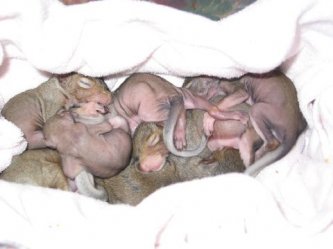 Gray squirrels have two litters a year. The first is early spring and the second is in the fall. The litter usually consists of 3 to 5 babies. They are born pink, blind and hairless. The first hair to develop is the whiskers. Squirrels grow slowly. They are dependent on their mother for six weeks. They open their eyes around 5 weeks and have their front incisors, but will not have their grinding teeth until around the sixth week. They may continue to nurse until the 12th week. The first litter will venture from the nest around the first week of May. The second litter will become active in August. Almost as soon as young squirrels leave the nest, they begin to bury nuts. Squirrel mothers are extremely protective of their young. They do not mate for life like their cousin the beaver. Young squirrels are not automatically accepted in a territory. They must establish their position. Squirrel home ranges vary from one to seven acres. Males have a larger territory than females. They will travel in rows of trees which they have marked with scent. Squirrels are quick and nimble. They are capable of running, climbing and jumping among the branches of the highest trees. They have extremely powerful back legs and can easily jump 6 feet. They are capable of climbing almost every surface with the exception of glass. They are capable of running 19 miles per hour. They are also able to swim up to one mile.
Gray squirrels have two litters a year. The first is early spring and the second is in the fall. The litter usually consists of 3 to 5 babies. They are born pink, blind and hairless. The first hair to develop is the whiskers. Squirrels grow slowly. They are dependent on their mother for six weeks. They open their eyes around 5 weeks and have their front incisors, but will not have their grinding teeth until around the sixth week. They may continue to nurse until the 12th week. The first litter will venture from the nest around the first week of May. The second litter will become active in August. Almost as soon as young squirrels leave the nest, they begin to bury nuts. Squirrel mothers are extremely protective of their young. They do not mate for life like their cousin the beaver. Young squirrels are not automatically accepted in a territory. They must establish their position. Squirrel home ranges vary from one to seven acres. Males have a larger territory than females. They will travel in rows of trees which they have marked with scent. Squirrels are quick and nimble. They are capable of running, climbing and jumping among the branches of the highest trees. They have extremely powerful back legs and can easily jump 6 feet. They are capable of climbing almost every surface with the exception of glass. They are capable of running 19 miles per hour. They are also able to swim up to one mile.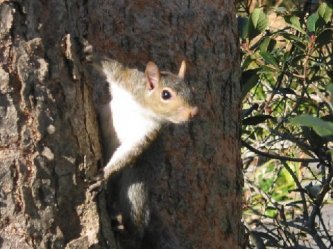 Squirrels have very acute senses. Their hearing enables them to be aware of any changes in their environment. They have powerful vision and a wide field of vision due to the placement of their eyes on the side of the head. It is believed they are able to distinguish color, with the exception of red and green. They are able to see fine detail in vertical objects. It is believed that a gray squirrel is able to recognize another at 50 feet away. They are able to see object movement twice as fast as the human eye.
Squirrels have very acute senses. Their hearing enables them to be aware of any changes in their environment. They have powerful vision and a wide field of vision due to the placement of their eyes on the side of the head. It is believed they are able to distinguish color, with the exception of red and green. They are able to see fine detail in vertical objects. It is believed that a gray squirrel is able to recognize another at 50 feet away. They are able to see object movement twice as fast as the human eye. The Eastern Snapping Turtle has a flattened carapace (upper shell) with knobby keels that smooth out with age. They can reach up to 19 inches in length and weighing from 10-35 pounds. It has a large head, small plastron (lower shell), and a long saw-toothed tail on the upper side. The carapace is brown and the plastron is cream to light brown with various degrees of black in it. The skin on the head, neck and limbs is dark brown to black. The large head has a blunt protruding snout. The carapace is often covered with algae. Breeding season is from April to November. Incubation is from 80-90 days and laying of the eggs usually happens in June. The eggs are hard shelled, white and spherical (like ping-pong balls) in shape. They lay their eggs in a flask shaped hole that the females dig in a variety of soils.
The Eastern Snapping Turtle has a flattened carapace (upper shell) with knobby keels that smooth out with age. They can reach up to 19 inches in length and weighing from 10-35 pounds. It has a large head, small plastron (lower shell), and a long saw-toothed tail on the upper side. The carapace is brown and the plastron is cream to light brown with various degrees of black in it. The skin on the head, neck and limbs is dark brown to black. The large head has a blunt protruding snout. The carapace is often covered with algae. Breeding season is from April to November. Incubation is from 80-90 days and laying of the eggs usually happens in June. The eggs are hard shelled, white and spherical (like ping-pong balls) in shape. They lay their eggs in a flask shaped hole that the females dig in a variety of soils. The snapping turtle is found throughout the state of Virginia including on some of the barrier islands. They have a large range of habitat. They are found in rivers, swamps, ponds, lakes, streams, freshwater, and brackish marshes. They are usually active from March through October but can be found any time of the year.
The snapping turtle is found throughout the state of Virginia including on some of the barrier islands. They have a large range of habitat. They are found in rivers, swamps, ponds, lakes, streams, freshwater, and brackish marshes. They are usually active from March through October but can be found any time of the year.